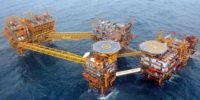HT had entrepreneurial ideas early. "In junior high, he had a plan to own a business," says his brother Hoa Tran, 34, a Safeway Corp. supply-chain manager. "He was always the disciplined one."
HT Tran says starting a restaurant overlooking the Pacific was what he had in mind. "Construction was not on the radar," he says.
But the pull of patriotism was stronger after 9/11, inspired also by his family's military tradition. Great-uncle Tran Van Chon, who supported Tran family members in Vietnam, was a career navy officer who became South Vietnam's chief of naval operations during the Vietnam conflict and an ally and friend of Adm. Elmo R. Zumwalt Jr., his U.S. Navy counterpart at the time.
Tran says his relative chose to stay behind after Saigon's fall and remained for 12 years in a Communist "re-education camp" until released with pressure from Zumwalt and others. Now 95, he lives in California. Tran's father, Hieu Minh Tran, who also served in the military, worked building tanks for a U.S. defense contractor after immigrating here.
Hoa Tran enlisted in the U.S. Marine Corps soon after 9/11, but his brother opted to finish college. HT Tran's height barred him from the U.S. Naval Academy, but he enlisted in the Army, assigned to its 10th Mountain Division, Anvil Company. Deployed to remote Kirkuk in northern Iraq, he gained construction, leadership and teambuilding skill. "We'd take over an Iraqi compound and build it into a tactical base, with machine-gun nests, perimeter security and living spaces," says Tran. "My construction experience was built on survival skills gained by our group to make it to the end of our deployment."
Tran's rise to weapons team leader was not lost on his new platoon boss, Capt. Clayton Hinchman, a West Point graduate who grabbed him as his radio transmission officer and right-hand man. "When I met HT, I knew I had to promote him and needed him to be that guy who watched my six. HT had all the qualities of a good leader from the first day I met him," says Hinchman. "He could communicate well, be analytical and be both aggressive and compassionate when needed. He wanted you to be the best because you were on his team."
Things changed drastically for both men and their platoon on May 10, 2008, when Hinchman stepped on an improvised explosive device (IED) during a midnight raid. The captain's leg was blown off, and Tran, who was promoted to sergeant, lost an eye and suffered injuries to his brain and leg in the blast, along with shrapnel wounds. The injuries ended both military careers but led to new ones in a 15-month recovery at Walter Reed National Medical Center in Washington, D.C. There, they encountered Bob Nilsson, a former Turner International president who, as a volunteer, was instrumental in their career reinvention.
Nilsson had eyed Hinchman for a possible job at Turner but also kept noticing Tran's quiet but intense interest in the classes. "He was absorbing everything like a sponge, and he kept coming back," says Nilsson. Hinchman went on to start a computer-network consulting company in Huntsville, Ala., for government clients. Half of the firm's 20 employees are veterans.
Also seeing Tran's potential was Michael Conklin, CEO of Sentinels of Freedom, a Bay Area-based nonprofit that helps transitioning wounded military with education scholarships and work options. "In HT, I saw motivation, drive and attitude," says Conklin, who networked Tran into a job at defense firm Northrop Grumman, where he gained key skills in procurement, project and financial management, and small-business contracting.
The experience pushed Tran to consider seriously a construction business. "The business is task-oriented with a chain of command, and I felt I could do it," says Tran. "But I realized my weaknesses—that I wasn't a civilian builder and not the most outgoing person in the world. I could manage a team but not open up doors."
Tran enlisted help from the well-connected Nilsson, who former colleagues compare to a "heat-seeking missile." The executive reached out to a broad network of industry contacts that included Richard Leider, a San Francisco real estate investor who also had strong local connections. Alan Guy, a rising project-manager star at Webcor who was looking for an entrepreneurial shot, signed on as partner and chief operating officer, while Leider was persuaded to join as business development partner. As the company's brand, Tran chose his Army company name, Anvil, which conveys permanence and steadiness, he says.
Networking also helped the firm form its board of real estate, financial and management expert advisers. "HT is strong enough to act alone but has the humility to know that his Anvil team makes him stronger by the rule of 10," says adviser Diane Miller, former CEO of Miller-Thompson Constructors, Richmond, Calif. "I was overwhelmed by his ability to listen and to question my past experiences in a growing company. He was excited to move forward with concepts that I passed on to him." She sold her firm to Weitz Construction in 2006.
The executive team set up shop in a 120-sq-ft room atop a bar and took no salary for the first three years. Anvil struggled to convince regulators, owners and peer firms that it was a legitimate small and veteran-owned firm, and not a front company. "It took HT almost a year to be certified by the Dept. of Veterans Affairs that he was retired military, a Purple Heart recipient and capable of owning a business," says Leider. Even with a well-vetted business plan, Anvil learned market realities when its original aim to target federal work was upended because it lacked three years of experience.
In the still recessionary market of its birth, Anvil "would do any job to build its resume," says Leider. That included installing 6,000 low-flow toilets for San Francisco's housing authority. Prospects improved when the firm won a low-bid general contract to renovate the city's iconic Coit Tower, built in 1929. The eventual $1.5-million project was "a good win," says Nilsson. Matt Jasmin, project manager for the city's Recreation and Parks Dept., says the project schedule challenged Anvil, but participants "were more facile with technology and software. I was impressed with their gumption to start a firm in such a competitive environment."




















Post a comment to this article
Report Abusive Comment